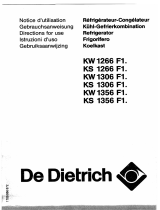20
en
Adjust temperature selector
to freezing and switch on
freezing process
Turn temperature selector to an
average temperature setting (approx.
“3”) whenever fresh products are put
in to freeze.
This temperature setting is sufficient for
freezing up to 2,5 kg of food. For larger
amounts you should additionally actuate
the freezing switch (Fig. E/22).
(Press the rocker switch -red marking
appears).
If takes approximately 24 hours for the
freezing process to reach full completion;
once the food is thoroughly frozen, you
may disengege the freezing switch.
Please observe following
when putting fresh food into
the freezer compartment:
Please carefully ensure that freshly
freezing food does not come into contact
with food which is already frozen.
Observe the following tips for
better storage of frozen food:
If the temperature of the room where the
appliance has been placed drops below
+18ºC the freezer switch should be
connected. A red mark will indicate it is
on (figure E/22). On connecting the
switch, the inner light will remain on at
reduced power. This ensures that the
temperature requiered in the freezer
compartment for long-life storage of
food is maintained.
Storage life
To avoid quality loss, it is important not
to be exceed the admissible storage life
assigned to each product. The length of
admissible storage varies from product
to product.Fish, cold slices, ready-
cooked meals bread and pastries will
keep out to two months at a temperature
of -18ºC. At the same degree of
temperature you may keep meat, poultry
and cheese for up to four months and
fruit and vegetables for up to six months.
Defrosting frozen products
Depending on the type of food and the
use intend for it, you may choose among
any of the following defrosting methods:
- at ambient temperature,
- in the refrigerator,
- in an electric oven.
- with/without fanheater,
- in a microwave oven.
You may refreeze food that has partially
or totally defrosted provided that:
- in the case of meat and fish, these
products were not kept for longer than
a day at a temperature of 3ºC or
higher;
- in the case of other products, these
were not kept for longer than three
days at a temperature of 3ºC or higher.
Otherwise, check food for smell,
appearance and flavour, if these have
remained unaltered, boil, fry, roast or
cook food to some kind of ready meal
and refreeze. Observe that the
maximum admissible storage life in this
case is shorter than average.













